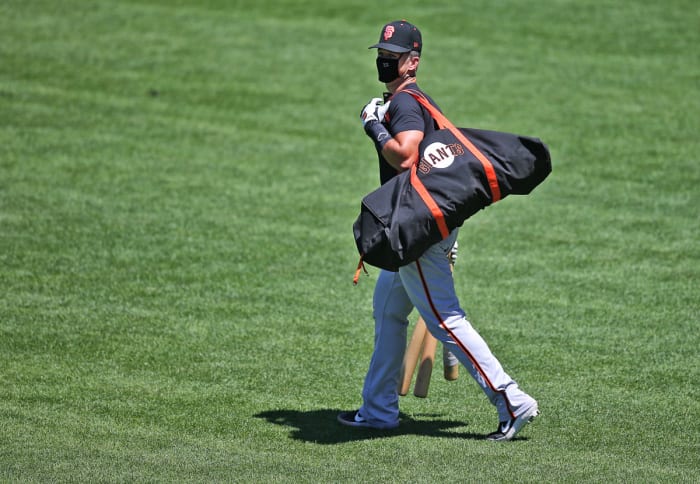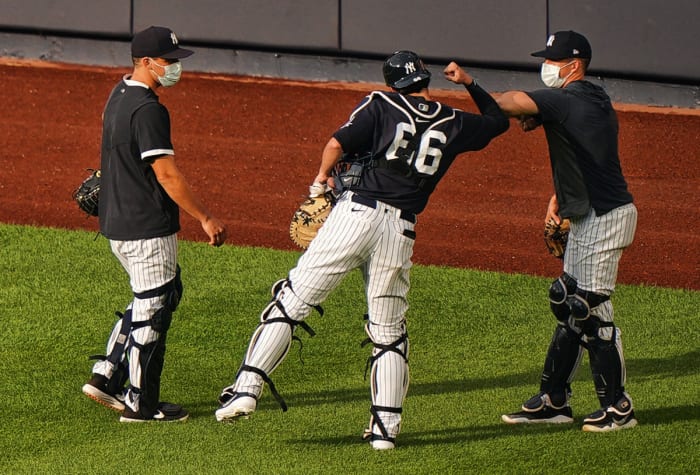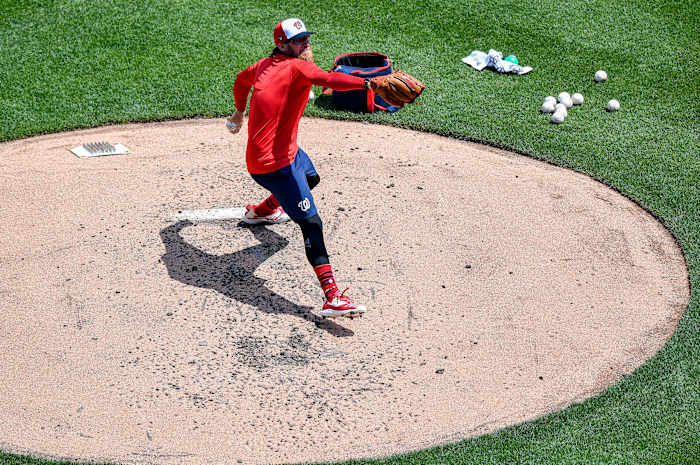As MLB players took the field this week for the first time in months—gradually adapting to major league life in a pandemic—the most important place in baseball sat hundreds of miles away from any of their stadiums.
The Sports Medicine Research and Testing Laboratory in South Jordan, Utah, is responsible for running all of the league's tests for COVID-19. And the initial impression of MLB's system was less than encouraging.
Results were late. Test collectors reportedly failed to come to some stadiums. Some tests were lost or seemed questionably accurate. Five teams were forced to cancel workouts as they waited to hear the status of samples sent to the lab two or three days previously. There was vocal frustration from players, managers, and front-office executives. In a Monday statement, MLB said that the July 4 weekend had been responsible for “unfortunate” delays and assured that there would not be a recurrence. But the holiday was not a satisfying answer for why the Giants had to call off their team workout to wait for results on Tuesday, or why Alex Bregman had to miss practice because of a delayed test on Wednesday. It left people around the game questioning: Is this a major league testing protocol?
“This has to get fixed,” said Nationals reliever Sean Doolittle.
“We need clarity,” said Astros outfielder Michael Brantley.
“Amazon packages can be delivered literally 7 days a week but results for Covid testing not so much,” tweeted A’s pitcher Jake Diekman. “@mlb thoughts?”
Ballplayers are not alone in their incredulity.
“The key to success with frequent testing is not just doing the testing,” says Dr. Neel Gandhi, an epidemiologist at Emory University. “It’s actually getting the results.”
***
The COVID-19 test program is one of the most crucial features of MLB’s return to play. It may also be the most complicated.
Do you test every day, or every other day, or every third day? Will players be tested more often than, say, clubhouse staff and groundskeepers? Do you use saliva samples or nasal swabs? A group of local laboratories or a single centralized one? What’s the backup plan if something falls through? Is your top priority accuracy or speed? (Or the financial cost?) How must you consider the impact on national testing resources?
There’s no one-size-fits-all program. But some answers here are better than others, and MLB's choices, experts say, could leave room for trouble.
The league says that it has tried to root its plan in the interests of the public. When commissioner Rob Manfred announced MLB’s decision to rely on just one laboratory—a drug-testing facility that had previously handled minor league doping tests—there were national headlines about test shortages. It was mid-May, and NBA teams were under fire for testing asymptomatic players while sick people were being forced to wait in long lines, if they had a chance to be tested at all.
So MLB’s plan was presented as a workaround of sorts. By using a lab that was already devoted to baseball, it could have its tests without accusations of acting selfishly. MLB took care of the upfront cost of reconfiguring the facility to handle COVID-19 tests: $250,000 to purchase the necessary lab instruments and $1.325 million for testing reagents, according to a league spokesman. (MLB is now being invoiced per individual test.) The facility has also committed to providing tests for players’ families and to local health care employees in major league cities.
“One of the principle reasons for using the Utah laboratory is to ensure that MLB is not diverting testing resources away from the health care system,” the spokesman wrote in a statement to Sports Illustrated, noting that the lab initially approached MLB, rather than vice versa. “The Lab was also cognizant of not taking away from valuable testing resources and structured a testing process that utilized refurbished laboratory equipment, and recommended sample collection devices that, while exceptionally effective and reliable for COVID-19 testing purposes, are not in scarce supply due to their uses in other types of testing and consistent domestic supply chain.”
Experts say, though, that MLB’s plan may come up short for both the public and its players.
It’s true that relying on a single private lab means that MLB isn’t taking preexisting tests that would otherwise be used for the general public. And a system that runs on saliva samples rather than nasal swabs addresses the issue of resources that can easily be strained by public demand. But COVID-19 tests do all rely on the same few supply chains—every lab, private or public, operates within the same broader ecosystem when it comes to the required reagents.
“Any amount of testing draws from the pool of available reagents, regardless of whether it’s performed at a private lab, an academic medical center, or a commercial reference laboratory,” says Dr. Benjamin Pinsky, medical director of the clinical virology lab at Stanford. “There’s a relatively limited number of suppliers, and there have been supply chain issues throughout the course of this pandemic, not just confined to the public sector versus private sector.”
A few weeks ago, this may not have felt like the basis for a serious discussion. Now, however, as cases continue to spike and the testing capacity in some areas becomes strained once more, it opens up a separate ethical question for a group like MLB.
“What are the ethics of professional sports occupying testing capacity if there isn't enough testing capacity for the communities that they're in?” says Gandhi. “I thought that that issue was over, and we didn't have to talk about it anymore when we got to the beginning of June. But unfortunately, in the past week or two weeks, I think we have to talk about it again. Because many of the locations that are seeing spikes right now are finding that they're butting up against testing capacities again. ... If the Utah lab could donate these tests to public health authorities, isn't that something that they should consider?”

Buster Posey's Giants were among the teams that had to cancel practice this week because of testing delays.
Brad Mangin/Sports Illustrated
***
Then there’s this question: Will the plan work?
“I think their approach to get results back rapidly is a very challenging way to organize a testing program,” says Pinsky. “There are a lot of other ways that it could be organized that could get the results back to players and teams more quickly.”
MLB’s system works like this: Players and managers have samples collected at the ballpark every other day. Each team’s “Tier 2” personnel—think clubbies and front-office employees—give a sample two to three times a week. These will typically be saliva, rather than nasal swabs, and they’ll be taken by representatives from a company called Comprehensive Drug Testing, which is also responsible for shipping the samples to the lab in Utah. (They use FedEx.) Upon arrival, the tests are supposed to be analyzed as quickly as possible, but the operations manual notably does not commit to a time frame for that: 24 hours is described as “a goal.”
“The biggest issue is a delay in getting results back,” says Andrew Pekosz, a professor of immunology and microbiology at Johns Hopkins. “Obviously, shipping samples, having them analyzed and then having the data sent back is all going to put extra time in between a test and telling someone the results.”
But the need to build in shipping time and the potential for delays are not the only obstacles. By relying on a single lab, MLB has streamlined its system, but it’s also centralized its risk: If there’s a problem that causes a backlog, it will affect all teams’ tests. And SMRTL, as a drug-testing laboratory, is now getting accustomed with new instruments and test methods, which can increase the chances of those problems.
“I was surprised that they decided to use a drug testing laboratory,” says Pinsky. “If they had to partner with a single reference laboratory, I think that they should do it with one that has experience with molecular diagnostics for infectious diseases, rather than a doping lab.”
In other words, for everything to go smoothly, MLB will need good sample collection (no more testers who fail to come to the stadium), no shipping delays (luckily, there’s not another holiday weekend until Labor Day), and minimal disruptions at the laboratory (which, again, does not traditionally do this type of testing). That’s without getting into the accuracy of the test itself, or the lack of any clearly designated back-up test sites, or the fact that every-other-day testing with a one-day turnaround still leaves time for the virus to be potentially transmitted.
It's a lot. But these details could be the difference between a full baseball season and a failed one. Several additional questions remain:
How many laboratories should MLB use?
There are some benefits to a test program that uses just one lab. There are, of course, the aforementioned ethical concerns about not dipping directly into local test facilities. The quality control can be more standardized; the system can be more streamlined.
But there are also drawbacks—like baseball saw this week. Delays. Backlogs. The necessity of cross-country shipments. If anything goes wrong, there’s nowhere else to turn. Unsurprisingly, MLB is reportedly considering the need for a second lab site already.
“I think the idea of trying to centralize the testing process can be problematic,” says Nadia Abuelezam, an epidemiologist at Boston College. “Just the process of shipping the sample to Utah, making sure that all the samples get there on time, are tested on time, have results back on time. ... Thinking about the ways that testing might be done more locally may be reasonable.”
Just for turnaround time, it would be ideal to have all samples tested as geographically close to their ballpark as possible. But there are factors to consider besides sheer timeliness—ethics, logistics, efficiency. In other words, new issues could arise from trying to use a different laboratory in each individual baseball city, particularly when any one of those communities could be experiencing a strain on its local test resources at any time. Still, there are practical ways to split the difference here: “four labs, one in each region of the U.S.,” suggests Gandhi, or some other configuration of “local and regional laboratories,” says Pinsky.
Even just one more lab could cut down on the time needed for shipping and ease the potential for disastrous backlogs.

Like other teams, the Yankees are getting accustomed to their new COVID reality.
Erick W. Rasco/Sports Illustrated
And what exactly do those laboratories need to do?
Of course, if a league is relying on a single facility, the quality of the laboratory is essential. But MLB’s choice raises some eyebrows.
When MLB announced its partnership with SMRTL, the league was open about the fact that the antidoping lab was not a traditional choice for infectious disease tests: This, again, was the basis for the ethical appeal for the program. Yet what did that mean for the ability to reliably process the tests?
Reconfiguring the lab involves more than buying a few new tools. Most drug tests are done with a technique called mass spectrometry. COVID-19 tests rely on an entirely different practice, known as a polymerase chain reaction, or PCR. The instruments are different. The methodology is different. The samples are different: The protocol for handling blood or urine is not the same as for saliva or nasal swabs. There are some basic skills that are generally similar across any form of lab testing—keeping track of lots of samples at once, guaranteeing proper documentation and so on. But the test itself is a whole other animal.
“It’s nice to have a laboratory that has a history of processing large numbers of samples in a relatively short period of time. The logistics there are important to have,” says Pekosz. “But it’s a very different kind of test, and oftentimes these tests do require a different level of expertise to run them truly effectively ... to help troubleshoot and solve problems that are very specific.”
SMRTL did not respond to requests for comment, but there’s no public evidence to suggest that the lab has worked much with this type of testing before. Of the 17 instruments that the lab advertises its experience with on its website, none can be used for PCR, according to three virologists who reviewed the list at the request of SI.
Of course, none of this means that the lab and its personnel can’t learn to adjust quickly. But it does mean that there’s potentially a learning curve that would have been absent in a lab that already did PCR—and in an environment where even experienced labs have struggled to push their testing programs at the necessary scale, that can make a difference, especially at the start.
“It’s the old saying that no battle plan survives the first attack, right?” says Dr. Geoffrey Baird, interim chair of the University of Washington Department of Laboratory Medicine. “You can have these great plans, and then all of a sudden, 8,000 specimens are on your front porch, and you have to actually test them. ... There’s just an enormous number of barriers to being able to do this well.”
What about the type of tests?
MLB says that it has decided to primarily operate with saliva samples rather than nasal swabs so as not to pull from the limited national supply of swabs. There’s just one problem: Experts say that the nasal swabs are more accurate.
“There are actually now basic scientific questions about the validity of saliva,” says Baird. “There are groups that do it. But there are concerns that it may not match the sensitivity of a good nasopharyngeal sample that’s collected by an experienced individual and processed appropriately. ... That’s the gold standard that we have right now.”
Consider the case of Rangers outfielder Joey Gallo. He has tested positive for the coronavirus twice with MLB’s saliva test ... and negative twice in the same span by personally seeking out nasal swabs at a private lab in Dallas. As a result, he’s been unable to begin practicing with the team. That’s not to say that the saliva test is automatically flawed or that it has no use. But if accuracy is a primary goal of the program, “nasal swabs are the way to go,” says Pinsky.

“This has to get fixed,” Doolitte said of the early results of MLB's testing plan
Jonathan Newton/The Washington Post/Getty Images
Just how much does this matter?
The plan to return to play is much bigger than testing, of course. There are recommendations for everything from socially distant baserunning drills to hygienic clubhouse behavior in the hopes that the chances of spreading the virus can be kept low. If everything else runs entirely as planned, then, how crucial are any flaws in the testing program?
“If you keep the number of infections down in your baseball community, then the weaknesses in the tests will be blunted if there's fewer cases,” says Dr. Thomas Russo, chief of infectious diseases at the University of Buffalo. “The ramifications of a 72-hour lag will be less.”
But MLB isn’t operating in a bubble. Even with strict rules, there will be room for the virus to sneak in, and without speedy test results, there will be little opportunity to identify it and block it from spreading. For a 60-game sprint that will see teammates around each other every day, each additional hour that it takes to run test results can be an additional hour for the virus to potentially spread.
“I think you really do need it within 24 hours,” says Gandhi. “With turnaround times that are longer, you’re flying in the dark.”
That leaves MLB trying to run a program that is fast, accurate, rigorous and appropriately sensitive to public testing resources. What's the best way to do that?
“I think I would answer that question with an entirely different question,” says Baird. “I think you have to ask if it’s sensible in the middle of a global pandemic to play a major league sport. And that question has not been adequately answered yet.”



































